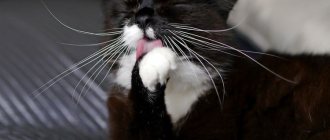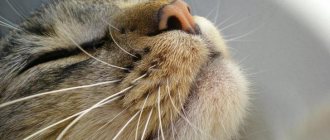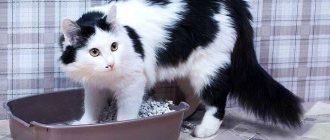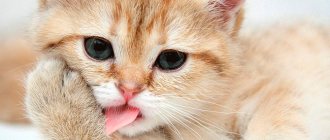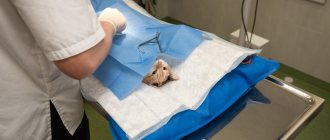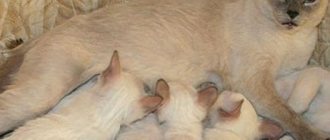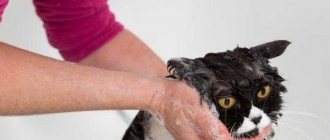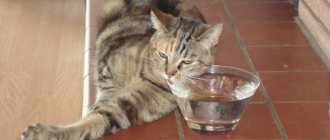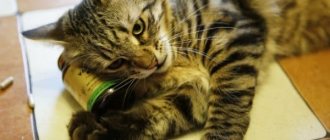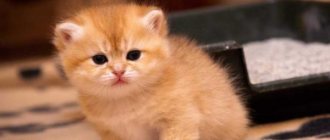Clinical symptoms
Sores in cats are localized mainly on the lower jaw.
Sometimes, in addition to the beard, black specks can be found along the line of the upper and lower lips. At the first stage of the disease, clinical symptoms are noticeable only in hairless cats in the form of small dirty dots. In 50-55% of cases, no further development of pathology occurs, and the animals do not show concern.
In 45% of cases, feline black comedones on the cat's chin progress to sores such as papules and pustules. Their symptoms are:
- the appearance of red spots on the skin of the chin;
- formation of painful tubercles;
- the appearance of a spherical or cone-shaped abscess, upon pressing on which a certain amount of purulent exudate is released.
If squeezing out the abscess and its subsequent treatment was carried out in compliance with antiseptic rules, then after 2-3 days a dry crust appears in place of the pustule. After its removal, no scars remain.
However, quite often the cat scratches the abscess on its own, which provokes the development of a secondary infection and the formation of a boil. Clinically this manifests itself:
- hyperemia and swelling of the chin tissue;
- an increase in local temperature;
- itching and soreness, which provoke further scratching;
- thickening of the skin in the lower jaw area.
After the completion of the process of maturation of the boil and the formation of a connective tissue capsule around it, pain and itching go away, the temperature returns to normal, and the purulent exudate is visible through a thin layer of skin.
Why do my mustaches fall out?
Hair loss is a normal process. Cats lose their whiskers in the same way as they lose their fur, this is a process of shedding. Normally, cats lose one or two whiskers at a time. You already know that they have many important functions, so they cannot all fall out at once - without whiskers, the cat will have a very difficult time. But it happens that the mustache falls out for other reasons.
Allergy
Losing mustaches may indicate an allergy. Cats' bodies often react to allergens with dermatological problems, such as skin irritation. Most often, mustache loss is a consequence of food allergies.
Infection
If an infection or fungus appears in the place where the whiskers grow, they can cause the whiskers to fall out. Bacterial infections such as ringworm can also cause hair loss.
Injuries
If the cat is injured in the place where the whiskers grow - for example, his whiskers and eyebrows are damaged - they may fall out. It's not just other animals that can cause injury. If a pet unsuccessfully rubs its muzzle against a tree or crashes into a wall in the midst of play, this can also cause it to fall out.
Cat acne
Cats, like people, get acne. Acne usually forms in the chin area. But it can spread to the cheeks and thus contribute to mustache loss. The main cause of acne is bacteria that grows on your cat's bowls. For prevention, it is better to use ceramic or metal bowls and wash them frequently.
Lost mustaches grow back. But if the loss is associated with veterinary problems, you need to solve these very problems first. Take your pet to a veterinarian, he will help determine the cause and select treatment if necessary.
Sometimes mustache loss is due to lack of nutrients. If the analysis shows that the animal is lacking something in its diet, it will have to be adjusted. The health of the coat and the whole body as a whole will be helped by providing SUPERPET species-typical nutrition. This food takes into account all the needs of cats and provides all the necessary macro- and microelements.
For your pet’s health, veterinarians recommend SUPERPET, a biologically appropriate diet.
Why does a kitten's whiskers break?
The most harmless case is genetic predisposition. A cat's whiskers break on their own, for example, in sphinxes.
This is how short a mustache can be
Does your cat's whiskers sometimes become soft and brittle? This is a sure sign of a lack of vitamins - vitamin deficiency. It is worth reviewing your pet’s diet or changing food. It is also possible to add some special vitamins, which your veterinary clinic can help you choose. The most unpleasant thing that possibly happened to the cat was that he developed worms. In any case, the sign that cats’ whiskers are breaking does not pose a particular health hazard.
If a kitten’s whiskers break, you should worry a little more, because the baby is still a growing organism. All that can be done in this situation, like a kitten’s whiskers breaking, is to add more vitamins to the kitten’s menu: a spoonful of vegetable oil in the porridge, a little cottage cheese at night or a little milk in the morning. Or change the dry ration in favor of something more enriched with minerals and everything necessary.
Does your cat's whiskers sometimes become soft and brittle? This is a sure sign of a lack of vitamins - vitamin deficiency. It is worth reviewing your pet’s diet or changing food. It is also possible to add some special vitamins, which your veterinary clinic can help you choose. The most unpleasant thing that can happen to a cat is that it gets worms.
Kittens lose their whiskers due to frequent breaking off when playing with others, and also because their mother cat can bite them off. Sometimes, curious children cut off their mustaches. It is necessary to monitor the kitten’s nutrition, choose carefully, and do not forget to give vitamins.
“For a healthy coat and whiskers, the cat needs to be given protein, B vitamins, ascorbic acid, vitamins A, E and D, as well as minerals - magnesium and calcium.”
Does the cat not grow whiskers?
However, there are times when you should still worry. The cat's whiskers have fallen out, or the cat's whiskers are turning black, or new ones are not growing? Perhaps the whole reason is parasites or a lack of collagen or vitamin A. In addition, a worse option is possible, if your cat likes to walk, the whiskers may simply not “grow”, but are constantly lost in fights (cats often also bite off whiskers from to sweep).
And, probably, the last option is that the cat’s whiskers fall out if he is infected with a tick or lichen. The tick must be treated. And the deprivation must also be detected first: for this, the animal’s face must be illuminated with a special Voodoo lamp (the deprivation will glow an emerald color), or a scraping must be taken - in any case, you need to go to a veterinary clinic.
How to spend less gasoline by planning your route correctly?
Often, from year to year, motorists persistently follow the established habit and drive from home to work or to other objects strictly along the same route, not realizing that they can choose a different route that will be less congested with vehicles, on which there will be fewer traffic lights and , after all, which will be shorter in distance. Choosing the optimal route among the possible ones will save gasoline. A navigator or a special program installed on your phone (2GIS, Google Maps or some other) will help you solve the problem of choosing the optimal route. You can also find out which road there is a traffic jam on at the moment, so as not to burn fuel in vain trying to drive along it, from other drivers, for example, by using a car radio.
Is it possible to trim a cat's whiskers?
Like other hairs, they gradually die and fall out, and new ones grow in their place. This process occurs throughout life and does not stop even in old age. Over time, they thicken, darken and gradually begin to turn gray. A fallen tendril is often only half colored. In addition, its end is generally very sharp. In older pets, the rate of replacement after loss slows down significantly.
Trimming a cat's whiskers is strictly prohibited! If you do this, they will grow back very slowly. In addition, the entire period of their regrowth will be quite difficult for animals to tolerate.
Vibrissae
Scientists have even conducted research by cutting off whiskers and observing changes in behavior. Some representatives continued to behave as usual, but most were scared and confused. At the same time, all experimental subjects had the following problems:
- Poor orientation in dark places and bumping into things around them.
- Getting stuck in narrow passages more often due to the inability to objectively assess their dimensions.
- Reduced jumping accuracy. They did not reach or landed on the side of the objects they planned to jump on.
- For cats that are only at home, this is not so scary. But for pets going outside, this is fraught with unpleasant consequences. The inability to accurately navigate in space can even pose a threat to their lives.
We doubt that adults will come up with the idea of cutting off a pet’s sense organs. But children are many times more curious and enterprising.
That is why it makes sense to explain to them from an early age that under no circumstances should you cut a cat’s hair.
After all, because of this, she will become quite clumsy, timid, nervous, and perhaps even stop communicating with her household.
Why do mustaches break?
A cat has sores near its mouth: How to help at home
If you see your cat chewing a plant, you need to rinse your mouth. This can be done with ordinary boiled water from a syringe without a needle. The cat must be firmly grasped by the withers, and the oral cavity and the skin around it should be generously irrigated with liquid.
If your cat does not want to be treated and refuses to take medications, read our article on how to properly give tablets and other medications to your pets:
When contacting chemicals, remember that acids are neutralized with alkali, such as soap, and alkalis with acids, such as acetic acid 2-3%.
In case of a thermal burn, the oral cavity can be rinsed with cool water, lubricate the area around the mouth with Bepanten, and try to prevent licking.
For ulcerations of unknown etiology, you can use Vinilin for a speedy recovery.
Food during this period should be soft. Replace the diet with pouches, pates or natural food ground into porridge.
See how to properly hold your cat during treatment
Why do cats need whiskers?
All animals from the cat family have good hearing, a sense of smell and a specific organ called whiskers (vibrissae) in the form of coarse hairs near the mouth, which have a pronounced function of touch. The bases of the organ are located on the surface of the skin and are connected to a large number of nerve endings.
Vibrissae transmit special impulses to the brain to receive certain information. Therefore, if you cut off a cat’s whiskers, it may lose important functions for the body:
- orientation in the environment. It is with the help of their whiskers that cats are well oriented in the place where they are, since the whiskers transmit impulses about the presence of possible obstacles. The animal’s brain begins to solve the problem after receiving the appropriate signal;
- moving a cat at night. This function is especially useful for elderly animals whose visual acuity is impaired;
- successful jumping by cats, since with the help of their whiskers the animals accurately calculate the distance, trajectory and angle, the force of the body flight for successful hunting and protection when meeting an enemy;
- normalization of the vestibular apparatus, which ensures the animal’s balance while walking, jumping, running;
- the mustache is an integral assistant during hunting, since the sense of touch helps to establish the direction of the wind, the smell of the prey and its path of movement in complete darkness;
- With the help of their whiskers, cats can determine the depth of various holes. Reflective impulses from the walls transmit a signal to the brain, and the animal can assess the danger of a particular situation for itself;
- cats without whiskers cannot normally determine the temperature of food, liquids and recognize their nutritional characteristics;
Why do cats purr and how do they do it?
- many experts confirm that with the help of their whiskers, cats can detect magnetic changes in the earth and predict meteorological weather conditions;
- one or another position of the whiskers may indicate the mood of the pet (spaced and raised whiskers indicate a strong interest in the cat, and if they are pressed to the muzzle, then the animal experiences a feeling of fear).
Therefore, if a cat’s whiskers are cut, the animal will lose all of the above functions, which will negatively affect its general condition.
The main components of a cat's whiskers
If you constantly observe the habits of these wonderful and affectionate animals, then why they need whiskers is not so difficult to guess. The most important components of a cat's happiness are: communication, hunting instinct and, of course, orientation.
Hunting instinct
When tracking its prey, each cat, first of all, uses its excellent hearing and vision. Tactile sensations are also at their maximum level at this time. Cats, touching the floor with their whiskers, feel all the vibrations that are created by the paws of mice. A mouse that tries to escape breaks the air currents with its movements, so the cat's whiskers begin to move. That is why a cat can easily determine which direction the prey has chosen for itself and purposefully heads in its direction. If a cat manages to catch a mouse, then, holding it in its teeth, it feels it with its antennae. In this way, she can distinguish whether her prey is alive or no longer alive. If the mouse is still alive, the cat will not eat it. She can play with her for a long time and torture her so that she finally stops breathing. And only then does he start eating. But why does a cat need a mustache if it is fed by its loving owners?
With its whiskers, a cat determines the safety of its food, regardless of whether it is a mouse or simple cat food. Cat breeders have probably already observed more than once that when a cat is presented with a plate of food, it stretches out its antennae towards it, sniffs the food and only then starts eating. This way she evaluates the safety level of her food.
If for some reason a cat has lost its whiskers, then it becomes very careful, touching food with its paw, walking around it or trying to move it from place to place. This situation frightens the cat and it becomes more cautious and insecure.
Orientation
Many pet owners have probably noticed that their cat's whiskers break for some reason. The most common reason for this is the strongest use of this organ in order to somehow navigate in space. When a cat moves around a room in complete darkness, it lowers its muzzle to the floor and thus feels all the vibrations passing nearby. Moreover, whiskers in the dark help the cat overcome obstacles and also calculate the route. Whiskers breakage occurs when the cat often moves in the dark and is nocturnal.
Communication
Based on the principle of how a cat's whiskers are positioned, you can understand what kind of attitude it has towards its owners, towards strangers, and even towards its rival cat. If you notice that the whiskers are scattered in different directions, then the cat is quite aggressive and it is not recommended to approach it. Sometimes cats bristle their whiskers during active play. If a cat presses its whiskers tightly to its muzzle, this may indicate that it does not want to let anyone near it. It is even possible that she does not feel very well or that she does not like this or that room, person or animal sitting next to her.
The cause of mustache loss is completely unclear in many ways. It happens that there are several animals in the house and one of them is constantly trying to pick out the whiskers of its “friend”. Scientific research has shown that this is one of the ways in which one cat wants to dominate another. Without antennae, a cat loses self-confidence, so it is much easier for the second one to subjugate it.
Is it possible to trim a cat's whiskers?
Without the covering of hair on an animal's face, their existence would become much more difficult.
Trimming cats' whiskers is prohibited. Cats without them will not be able to navigate the terrain. A mandatory property of the mustache is that it plays the role of a tactile and olfactory receptor.
Do not cut your mustache under any circumstances, even for preventive purposes. Even if it seems to you that they have become quite long and are starting to interfere with the animal’s movement, this will still be a bad idea.
It is necessary to understand that vibrasses for animals are the most important organ that transmits feelings; without it, the animal will become very powerless.
Vibrissae
This is the scientific name for the hair on your pet's face. Speaking about why a cat needs a mustache, it is important to note that zoologists have studied this issue quite closely, and today there are well-founded answers. Vibrissae are a sixth sense organ that has a connection with the brain. One can only regret that you and I are deprived of such a tool. You can already say what will happen if you cut off a cat’s whiskers. This is about the same as if he were deprived of an eye, ear or nose. The brain will not be able to receive important signals and respond to them properly.
Why do cats' whiskers turn black or white?
The color of the whiskers directly depends on the color of the animal itself. They can be white, black, red or several colors at the same time. Usually a black cat has black whiskers, but sometimes white whiskers are normal. In some breeds they turn black over time.
If a cat with a white mustache has acquired a black color, this phenomenon also does not mean anything terrible, just a normal change in hair pigmentation. You should be wary if the color, on the contrary, changes to white. Sometimes this can be a symptom of a disease. Therefore, even with a slight deviation, it is worth consulting with a veterinarian.
It's hard to imagine a cat without a luxurious mustache! However, nature did not invent them for beauty. Century after century, whiskers have helped cats survive in the wild, and today house hunters cannot do without them either. So what is their function? About this in our article.
What is the correct name for a cat's whiskers and what are they?
Cats' whiskers grow not only under the nose, but also on the forehead, near the eyes, on the chin and even on the paws. More precisely, it is correct to call them not “whiskers”, but “vibrissae”. These are sensitive, hard hairs, longer than the coat. In total, there are about 40 such hairs on a cat’s body, and only 24 of them are on the face.
Unlike simple hair, vibrissae are surrounded by hundreds of nerve endings and muscle fibers, and their root goes deep into the tissue.
Each whisker is a separate organ of touch, which continuously transmits a signal to the animal’s brain 24 hours a day. Vibrissae are present not only in cats, but also in many other mammals, including dogs.
Why does a cat need a mustache?
Vibrissae pick up the slightest vibrations in the air and help cats navigate in space. With such “devices”, even at night in an unfamiliar room, the cat will not crash into objects, will always smell the mouse and accurately calculate the jump distance.
Vibrissae help the cat understand whether food is safe. In the wild, the hunter seems to wrap her whiskers around a caught mouse, determining whether the prey is dead and whether it is possible to start eating. In a similar way, your pet analyzes food and treats at home
Caution in such matters is never superfluous!
Vibrissae serve for cats to communicate with each other and with humans. An attentive owner will always determine the mood of the pet by the position of the whiskers.
Is it possible to trim a cat's whiskers?
Is it possible to shorten cats' whiskers? Any specialist will answer: under no circumstances. The vibrissae are an important organ, the loss of which will result in extreme stress for the cat. A cat that suddenly loses its whiskers will become less aware of space and will feel defenseless and vulnerable until new ones grow.
Adults must explain to children that pulling out a cat's whiskers is prohibited. In addition to loss of function, it is also very painful, since the whiskers, unlike wool, are rooted deep into the tissue. Cat whiskers must remain untouchable!
What to do if your cat's whiskers fall out?
Now we know how important whiskers are for a cat. But what if they suddenly started falling out? Should we sound the alarm?
From time to time, the vibrissae are renewed in the same way as animal fur and human hair. Therefore, if you notice a fallen or broken mustache at home, there is no need to worry. This is fine!
It’s another matter if the vibrissae fall out and break in large numbers. This is a signal that something is wrong with the body. Perhaps it is a matter of seasonal adjustment, or perhaps an internal illness. Don't ignore the problem and contact your veterinarian.
Differences from animal hairs
There are physiological characteristics. The vibrissae are planted very deep into the skin; these are not ordinary hairs at all. Each whisker is an antenna that is surrounded by nerve cells. This is necessary to transmit signals directly to the brain center. But that is not all. Vibrissae are equipped with muscle fibers. That is, it is not hair at all, but rather complex receptors. In fact, they are responsible for the sense of smell, they just changed during evolution. The longest and most sensitive mustaches are located on top, shorter ones can be seen in the chin area. Remember that cats hunt at night, they need to quickly and silently find and catch a rodent. It is thanks to the whiskers that a cat can feel an object without contacting it and avoid colliding with an obstacle. What happens if you cut a cat's whiskers? He will lose a huge flow of information. Of course, this is not fatal at home, but it affects the well-being of the pet.
The main causes of breakage and loss of whiskers in cats
Whiskers and eyebrows in cats contain keratin, so if they break or are constantly falling out, you should study the possible causes of this condition:
- the development of vitamin deficiency, since the lack of essential vitamins and ascorbic acid in the animal’s body leads to insufficient production of keratin, which strengthens the pet’s mustache;
- the appearance of allergic reactions, which may be accompanied by mustache loss;
- disruption of the endocrine system (diabetes mellitus, lack of hormones also cause characteristic signs of withdrawal and loss of whiskers);
- the presence of various dermatological diseases (ringworm, parasite infection, fungus, other pathologies);
- Lack of sufficient collagen in the daily diet also affects whisker growth in animals.
A distinctive feature of Sphynx cats is the presence of short mustaches with curls, so for them this length is considered the norm and should not cause suspicion.
Most often, cats lose their whiskers when there are small children in the house who do not yet understand how serious animal twitching is. In such cases, you need to try to explain to the child that his actions are harmful to your beloved pet.
If the cat does not grow new whiskers, then he could damage the hair capsules, which contributed to normal growth and restoration of the whiskers. Therefore, consultation with a qualified veterinarian is required.
What disorders are associated with loss of mustache?
The sudden loss of a large number of mustaches is associated with the development of the following diseases:
- vitamin deficiency (lack of vitamin A, D and some microelements in the pet’s body);
- diseases of the thyroid gland (hypothyroidism, hyperthyroidism);
- diabetes;
- allergic reaction to food or certain substances;
- metabolic disease;
- skin diseases.
If a cat loses a significant number of its whiskers by the roots, it must be shown to a veterinarian. Self-medication will worsen your pet's condition.
How many whiskers do cats and cats have - varieties
Cats typically have about 24 whiskers on their faces, 12 on each side, in a horizontal pattern of four rows.
At the same time, these hairs are several times thicker and coarser than ordinary wool, and the depth of their roots is 3 or even 4 times greater.
The type of bristles located on both sides in the area of the nose above the upper lip of the animal (as children drew in their drawings in childhood) are considered the hardest, thickest and longest.
Due to their mega-sensitivity, the cat processes a colossal amount of information, and the loss of these particular formations can lead to partial disorientation of the animal.
A cat's whiskers are hard and fairly thick hairs, which are located several times deeper than the rest of the fur, as we found out earlier.
Scientifically, such whiskers are called vibrissae, which comes from the word to vibrate. The antennae grow individually and are enveloped in a constellation of nerve endings that have direct contact with the animal’s brain.
Each of them is individually responsible for a specific part of the cerebral cortex. Any damage or loss of one of them will cause slight disorientation subsequently of the type of functioning for which it is responsible.
Also, in addition to perceiving their surroundings, cats can express their emotions thanks to these hair formations. For example, if the antennae point down, then your pet is most likely puzzled or sick about something.
The structure and location of the whiskers in cats
Whiskers have been present on the faces of both male and female individuals since birth. The presence of this important organ does not depend on breed or genetics. But the difference in the length and thickness of the whiskers is associated with individual characteristics: breed, sex of the individual, conditions of detention. Knowing their structure and location will help you find out why a cat needs a mustache.
What are they made of?
The long hairs on the cat's face have an interesting structure. Each whisker is connected to a specific part of the brain and is responsible for the functioning of a specific system of the animal. This is why a cat needs whiskers: from the signals from the whiskers in the pet’s head, a complete picture of what is happening is formed. The hairs themselves grow up to 5-7 cm and consist of:
- nerve endings;
- skin glands and epidermis (the part invisible to the eye);
What happens if you trim your mustache
The consequences of losses are difficult to predict; they are varied and depend on individual characteristics, whether the cat is a street or domestic cat.
What happens if you cut off a cat's whiskers?
- Pets will begin to look for secluded places and be reluctant to communicate with the owner.
- Street - will have problems finding food, will begin to miss the victim more often, remain hungry until the whiskers manage to grow back.
Navigation disorders are the answer to the question of what will happen if cats' whiskers are trimmed. For some time, the animal will lose the ability to easily navigate the space around it.
The problem appears:
- inability to walk in a straight line;
- frequent falls;
- collision with furniture;
- various injuries.
Failure in behavior is associated with the absence of habitual signals about obstacles and health hazards. Such deviations are not typical for everyone. In most cases, the problem manifests itself as difficulty in jumping, free orientation in the dark, or in unfamiliar surroundings.
Vibrissae help cats maintain perfect balance
Experienced breeders report the following deviations in the behavior of young animals and adult pets, which will happen if you cut off a cat’s whiskers:
- inappropriate behavior based on stress and fearfulness;
- lack of contact, withdrawal into oneself;
- lack of physical activity;
- increasing the amount of sleep.
Important! Comfortable conditions for a cat that has lost its whiskers will provide an opportunity to reduce the risk of injury, but will not ensure its peace of mind
Will they grow back?
During scientific research, parts of the test animals had their whiskers removed completely or partially. Behavioral studies have shown that pets are more likely to get stuck in narrow holes, miss them, and be unable to get into them. Such failures had a bad effect on the psyche, the cats began to be afraid and hide, giving up any attempts.
You should not conduct your own experiments on a cat and trim its whiskers. It will take her a long time to grow them, and all household members will have to endure outbursts of aggression and other unpleasant reactions from a mentally unstable psyche.
Inappropriate behavior is the result of loss of vibrissae
Do cats grow whiskers?
Recovery will take some time. Their growth rate is three times faster than fur regrowth. Despite this, veterinarians warn that cutting the whiskers means losing the organs of vision.
Consequences of loss
The consequences of trimming cats' whiskers can be very varied and depend on whether the animal is a pet or an outdoor one, as well as on individual characteristics. The most difficult situation for the lack of their sensory sensors is street cats who are forced to get their food in the wild. Without whiskers, it will be difficult for backyard predators to track their prey and hunt successfully.
What happens if a cat's whiskers are trimmed depends on the individual sensitivity of a particular pet. At first, some animals may lose the ability to navigate normally in the surrounding space.
There are cases where cats deprived of whiskers could not walk in a straight line for a certain time, fell and lost orientation in space. This failure in the animal’s navigation system is due to a sharp lack of signals about the environment entering the brain.
Of course, such extreme manifestations are not typical for all animals. Most often, the loss of whiskers leads to the fact that it is more difficult for a pet to make accurate jumps and navigate in the dark. Without whiskers, a cat more often stumbles upon obstacles and does not navigate in an unfamiliar environment.
Veterinary experts under no circumstances advise owners to trim or trim their animal's whiskers. Such manipulation can lead to stress, fearfulness, and inappropriate behavior. Some especially sensitive pets have a hard time coping with the loss of their whiskers: they become withdrawn and become non-communicative. Cats sleep for a long time and stop leading an active lifestyle.
To see what happens if you cut a cat's whiskers, watch this video:
Functions of vibrissae
The purpose of the mustache is to be a kind of radar, an organ of touch. The longest, hardest and most sensitive ones are located above the upper lip, shorter and less sensitive ones are on the chin, under the eyes, all over the body, on the ankles, pads of the paws and even on the tail.
An adult cat has 12 hairs on each side of its cheeks. The average hair length is 6 centimeters. It is noteworthy that the cat's longest whiskers come from Finland. For this feature, it is even included in the Guinness Book of Records. The length of its whiskers is 19 cm.
The vibrissae give the cat the opportunity to explore the world around them and at the same time protect it from danger and are responsible for maintaining balance. It is thanks to their whiskers that cats are excellent hunters and can navigate in the dark without any problems. With their help, animals examine food for taste and freshness.
In addition, they are an indicator of mood - an angry cat tries to press the whiskers as close to the muzzle as possible, while in a good-natured animal the whiskers are directed forward. It is not surprising that many pet owners are concerned about this question: what will happen if a cat’s whiskers are cut off?
The necessity of cat whiskers and what they are scientifically called
Why do cats need whiskers? Whiskers are a sensitive organ of touch for cats.
With the help of its whiskers, the animal navigates space, studies surrounding objects and finds prey.
This organ acts as a collector of information that it transmits to the brain.
Areas of the body where the mustache is located:
- On both sides of the nose.
- Above the eyes.
- On the sides of the head.
- On the ankles of the front paws.
- On the tail.
In total, the animal has from 30 to 35 whiskers with an average length of 5-6 cm. The largest number of them is located on the head.
With the help of whiskers, a cat controls the prey when it holds it in its teeth
The scientific name for animal whiskers is vibrissae. The word comes from the Latin vibrissae, which means to oscillate, to wriggle.
Causes of acne on the chin of cats
There are actually no known causes for cat acne on the chin. But some possible factors include:
- Stress
- Poor care
- Dermatitis
- Bacterial overload (eating from dirty bowls)
- Impaired production of sebum (fatty substance)
- Contact hypersensitivity
- Suppressed immune system
- Concomitant infection or disease
Plastic cat food bowls were once considered a possible cause of acne in cats (allergic or contact hypersensitivity). With new research, it is believed that the real problem is the level of bacteria found in plastic utensils. Switching to glass, metal or ceramic cookware can help get rid of acne in some cases. I recommend stainless steel
But it is equally important to wash bowls frequently, at least once a day. If you use plastic, use this tip first
If this is the reason, then improvements begin to be tracked after a week or a week and a half.
In addition to the above, think about raising food and water bowls. You should try to do this in such a way that the cat’s chin does not come into contact with the contents of the bowls.
Just like humans, cats develop acne due to allergies. You should change your cat's food and treats to make sure they don't contain the ingredient that is causing the allergic reaction. You would likely notice other allergic symptoms and signs if your cat had a food allergy or allergic contact dermatitis, but not always.
Diagnosis of acne and pimples in cats
Diagnosis of acne, as well as the diagnosis of acne in cats, should be carried out exclusively by a veterinary dermatologist. Only such a veterinarian is able to exclude other variants of dangerous diseases and problems, such as ticks, fungal and bacterial infections (primary or secondary), or fleas. Among other things, you need to accurately assess the cat’s general health and how much acne bothers her and how much discomfort it causes her. Research and diagnostic techniques include: skin scraping for microscopy, as well as culture to identify fungal spores and bacteria.
In severe cases where the skin is red and tender, a biopsy may be performed. This is necessary because acne can mimic other more serious ones.
If the cat has lost its whiskers
Sometimes this is a necessary measure. For example, if surgery is required, the veterinarian will have to shave the fur together and whiskers to treat the entire area. This procedure is extremely painful for cats. This is another reason why cats should not have their whiskers trimmed.
The owners confirm that in this case the pet is literally replaced. His emotional background changes, the cat is in a bad mood. This is not surprising; her spatial orientation is impaired, and her brain is not yet accustomed to the changes.
What happens if you cut a cat's whiskers: will they grow back?
The questions of what will happen if a cat’s whiskers are trimmed and how the pet will react to this are important for all owners of these pets. Veterinarians do not recommend getting rid of coarse hairs - some felines lose orientation in space for almost a month after such a procedure and can seriously harm themselves.
A kitten without a whisker loses orientation in space
Vibrissae are the sixth sense organ directly connected to the brain. With their help, life is regulated: from touch to communication with furry fellows. If you don’t know why cats absolutely cannot have their whiskers cut, you can seriously harm them. Whiskers are not ordinary fur, and their loss deprives the pet of the opportunity to safely walk down the street, explore unfamiliar types of food, or hunt.
A kitten without whiskers loses orientation in space Vibrissae are multifunctional devices designed by nature as an additional sensory organ. They help cats hunt. A running mouse creates air vibrations that are instantly picked up by a small predator. The pet determines:
- the exact location of your victim;
- her condition;
- the point to which the enemy moves.
After capturing the mouse, the hairs growing on the cat's front paws come to the rescue. With their help, she controls the behavior of the victim, assesses the situation, determines the location and strength of resistance of the rodent or bird.
When communicating with fellow creatures, the mustache plays a big role. An animal’s reaction to the appearance of an unfamiliar individual or person can be determined by the position of its whiskers:
- If they are aimed at the subject of study, then the pet is interested in communication, it emanates friendliness.
- If they are pressed together with the ears, then attempts to pet the cat will lead to scratches, bites and the rapid disappearance of an aggressive animal.
Important! Vibrissae are the first to form during the embryonic development of babies. They help the newborn quickly establish contact with the outside world, identify the mother and brothers
It’s better not to even think about what will happen if a newborn cat’s whiskers are trimmed. You should not do this, because until they are restored the baby will be deaf and blind and will be afraid to move.
Difference from hairs
The physiological characteristics of vibrissae include their deep insertion into the skin. Each of the antennae is a kind of antenna, surrounded by many nerve endings. They are used to transmit received signals to the brain center.
Vibrissae are complex receptors equipped with muscle fibers. They are responsible for the sense of touch, and their appearance is associated with evolutionary changes in the furry pet’s body. The longest ones are located on top, the shortest ones are located in the chin area. The main help of sensitive antennas is the ability to quickly and silently hunt birds and rodents at night.
Whiskers help cats hunt
Important! By the whiskers you can evaluate the cat's next action. Splayed - intended to intimidate the enemy, directed in the opposite direction - indicate anxiety and uncertainty of the pet
Sensitivity
Resourcefulness and cunning are important character traits not only of an adult, but also of a small kitten. If you cut a cat's whiskers, what will happen to it:
- sensitivity to possible danger will decrease;
- the definition of the road will be lost in complete darkness;
- the reaction to environmental changes will disappear.
Touch is one of the important functions of vibrissae. With its help, pets will find out the safety of the food offered and its freshness. In pitch darkness, the animal easily avoids objects standing in the way by touching them with its whiskers. In some cases, direct contact is not necessary: due to the mobility and vibration of hard hairs, air vibrations are created, the reflection of which from foreign objects is caught by the vibrissae. After transmitting the signal to the brain center, the cat receives a three-dimensional image of space.
If a cat's whiskers are cut off, what will happen to it during a chase:
- she will not be able to determine the diameter of the hole she is going to crawl into;
- may get stuck in it;
- she will not be able to hide from her pursuer.
Important! Veterinarians have noticed that the loss of sensitive hairs for various reasons leads to the development of neuropsychiatric disorders in furry pets. They lose the skills to receive and process information, become defenseless, and behave inappropriately
Does a mustache grow?
Animals can lose their whiskers for a variety of reasons. For example, an animal can very easily damage its whiskers when approaching a heat source or break them in a fight with another animal.
Also, since it's actually hair, it's completely normal for your mustache to fall out on its own from time to time. However, they are usually replaced gradually so that the animal does not lose all of its whiskers overnight.
Most mammals' whiskers grow back, and although it takes some time, the whiskers will eventually return.
Why hairs fall out
If it’s not just another change of coarse hairs, then why does a cat’s whiskers fall out – a question that inexperienced owners often ask online
Loss of whiskers occurs due to disorders in the animal’s body, so it is important to recognize the symptoms in time and take action. We suggest you read: How to teach a cat commands: give a paw, bring a toy, walk on its hind legs || We teach a cat to follow 8 commands - little secrets and tricks
We suggest you read: How to teach a cat commands: give a paw, bring a toy, walk on its hind legs || We teach a cat to follow 8 commands - little secrets and tricks
Hypothyroidism usually occurs in older cats. This disease affects all body systems and leads to increased metabolism. In addition to the loss of the mustache, other signs are observed:
- wool properties deteriorate;
- the animal is hyperactive and noticeably nervous;
- appetite increases with weight loss;
- the pet experiences increased thirst, which it constantly strives to satisfy;
- sometimes diarrhea and vomiting occur.
The roots of the whiskers, compared to the roots of the fur, are located quite deep in the skin. They are surrounded on all sides by nerves, blood vessels and sensitive muscles. The development of a bacterial skin infection or the proliferation of parasites in the facial part of the head often explains why a cat's whiskers fall out. Such pathologies, accompanied by unbearable itching, are easily identified during an initial examination of the skin.
These disturbances in the hormonal system lead to changes in metabolism. Diabetes mellitus in middle-aged and elderly cats is usually indicated by such signs as increased thirst and frequent urination, excessive appetite against the background of general exhaustion of the body. The pet needs immediate help, otherwise the patient’s condition will worsen, and the loss of the antennae, compared to other problems, will no longer be noticeable.
The cat's body, like the human body, can react completely unexpectedly to some foods. Loss of whiskers and fur, accompanied by itching, redness of the mucous membranes, profuse salivation and discharge from the eyes - a condition caused by an allergic reaction.
Non-food allergies can be triggered by a variety of chemicals, certain types of plants and other objects that appear in a cat's environment. It is sometimes very difficult to determine what exactly caused the rebellion in the body; you have to use the method of elimination. The course of treatment will require the use of antihistamines.
In any case, you don’t need to think long about why your cat’s whiskers are falling out - a veterinary clinic specialist will explain in detail what to do in this situation.
Mustache problems and their causes
As they grow older, the vibrissae break off and fall out. It's quite normal. In all other situations, it is important to timely determine the causes of this phenomenon and take appropriate measures.
Why does a cat's whiskers fall out?
If you notice that there are much fewer antennae on the face than there were before, there is reason to think about the root cause of this phenomenon. Here are the most popular:
- Lack of vitamins. It leads to partial loss of hair and whiskers.
- Self-renewal. This process lasts a lifetime and is considered normal.
- Age. With aging, the number of vibrissae may decrease.
- Development of diseases. Some diseases may cause them to fall out or break off.
- Various damages. This can happen accidentally during a fight or active leisure time.
Females that have given birth usually gnaw off the antennae of their kittens. This protects them from moving too far from their mother, and, therefore, reduces the likelihood of them getting into dangerous situations.
If you begin to observe loss of vibrissae, do not immediately panic. Contact your veterinarian for advice. He will find out the cause and prescribe appropriate treatment if necessary.
Barbel
Why do mustaches break?
Factors influencing their loss also contribute to increased fragility. In addition to them, the following reaction to external circumstances is likely to occur:
- The indoor air is too dry. This is especially true in winter, since heating devices dry it out greatly.
- Excessive bathing, as well as the use of poor quality shampoos.
- Hormonal changes during adolescence.
- Not drinking enough. Fresh and clean water should always be freely available. Refusal or excessive use of it signals the need to contact a clinic for specialist advice.
In addition, problems sometimes arise due to an unbalanced diet. In this case, the mustache loses its elasticity. This can manifest itself both with natural food and with the consumption of ready-made food.
Now you know why a cat needs a mustache. Monitoring them will allow you to notice changes in your pet’s health in time.
Causes of acne on the chin of cats
There are actually no known causes for cat acne on the chin. But some possible factors include:
- Stress
- Poor care
- Dermatitis
- Bacterial overload (eating from dirty bowls)
- Impaired production of sebum (fatty substance)
- Contact hypersensitivity
- Suppressed immune system
- Concomitant infection or disease
Plastic cat food bowls were once considered a possible cause of acne in cats (allergic or contact hypersensitivity). With new research, it is believed that the real problem is the level of bacteria found in plastic utensils. Switching to glass, metal or ceramic cookware can help get rid of acne in some cases. I recommend stainless steel
But it is equally important to wash bowls frequently, at least once a day. If you use plastic, use this tip first
If this is the reason, then improvements begin to be tracked after a week or a week and a half.
In addition to the above, think about raising food and water bowls. You should try to do this in such a way that the cat’s chin does not come into contact with the contents of the bowls.
Just like humans, cats develop acne due to allergies. You should change your cat's food and treats to make sure they don't contain the ingredient that is causing the allergic reaction. You would likely notice other allergic symptoms and signs if your cat had a food allergy or allergic contact dermatitis, but not always.
Diagnosis of acne and pimples in cats
Diagnosis of acne, as well as the diagnosis of acne in cats, should be carried out exclusively by a veterinary dermatologist. Only such a veterinarian is able to exclude other variants of dangerous diseases and problems, such as ticks, fungal and bacterial infections (primary or secondary), or fleas. Among other things, you need to accurately assess the cat’s general health and how much acne bothers her and how much discomfort it causes her. Research and diagnostic techniques include: skin scraping for microscopy, as well as culture to identify fungal spores and bacteria.
In severe cases where the skin is red and tender, a biopsy may be performed. This is necessary because acne can mimic other more serious diseases that should be ruled out first. It could be ringworm, skin mites, or even fungal yeast infections. All of this should be ruled out before any treatment is started.
Here are more photos of symptoms and signs of acne and pimples on the chin of cats
Help for a cat that has lost its whiskers
Any problems associated with a cat's whiskers are not only caused by harmless reasons. They often indicate the development of a serious illness in a cat.
Prevention of antennae loss consists of a small list of measures, which include:
- Air humidification in the apartment. Excessively dry air negatively affects the health of the cat.
- Proper feeding of a mustachioed pet. Regular intake of essential nutrients into the cat’s body maintains and strengthens its health and, accordingly, the condition of its whiskers. It is also important to change your pet's water daily. A drinking bowl should be freely available.
- Timely treatment against ectoparasites and helminths.
- Vaccination on time.
- Refusal to self-medicate kitty.
In a word, if a cat lives in comfortable conditions and receives adequate nutrition, he will not face problems with whiskers. But if your cat continues to lose its whiskers, and their general condition has noticeably worsened, you should consult a veterinarian as soon as possible. This is a clear symptom that indicates a problem in the cat’s body. An experienced veterinarian will definitely send the animal for tests and prescribe a specific course of treatment. Treatment will be aimed at eliminating the disease that leads to the loss of antennae in the pussycat.
On the part of the owner, strict adherence to the veterinarian’s instructions, implementation of prescribed recommendations and therapeutic procedures is required. As a rule, the cat is sent home for treatment. But in severe cases, hospital stay is required. If you follow your doctor's instructions, the effect of treatment will come very quickly.
Options for what will happen to a cat’s whiskers if they are cut: will they grow back?
The questions of what will happen if a cat’s whiskers are trimmed and how the pet will react to this are important for all owners of these pets. Veterinarians do not recommend getting rid of coarse hairs - some felines lose orientation in space for almost a month after such a procedure and can seriously harm themselves.
Will they grow back?
During scientific research, parts of the test animals had their whiskers removed completely or partially. Behavioral studies have shown that pets are more likely to get stuck in narrow holes, miss them, and be unable to get into them. Such failures had a bad effect on the psyche, the cats began to be afraid and hide, giving up any attempts.
You should not conduct your own experiments on a cat and trim its whiskers. It will take her a long time to grow them, and all household members will have to endure outbursts of aggression and other unpleasant reactions from a mentally unstable psyche.
Inappropriate behavior is the result of loss of vibrissae
Do cats grow whiskers?
Recovery will take some time. Their growth rate is three times faster than fur regrowth. Despite this, veterinarians warn that cutting the whiskers means losing the organs of vision.
Further care for the animal if its whiskers have been cut off
How to wash a cat: options if he is afraid of water and scratches
Do lost whiskers grow back in cats: even after trimming the hairs on the eyebrows and chin, they will be restored in 14-21 days. There are no special means to accelerate their growth - doctors advise using multivitamin complexes specifically designed for animals. They allow hairs to grow faster and become thicker.
Natural recovery will occur provided that no damage to the hair follicle occurred at the time of loss of the mustache. Animal care includes:
- protecting it from hot objects: fireplaces, gas and electric stoves, candles;
- using a special cap will help reduce the risk of head injuries;
- if a pet is placed in a cage for a while, then it will not be able to accidentally harm itself;
- an injured animal should not be allowed out into the street - there it can get under the wheels of a car, fall from a height, crash and damage not only its paws, but also its head.
Each new haircut of the whiskers will cause aggression in the pet towards its tormentor. If there are children in the house, then they immediately need to be explained why there are hard hairs on the cat’s body and what the risk of losing them is.
Trimming whiskers will not make a cat look beautiful; they play a big role in choosing a partner and communicating with familiar and unfamiliar relatives. Having lost their sixth sense organ, animals cannot hunt or move through previously unexplored places.
Nature has protected furry pets, but it will take a long time to recover from the loss, during which time they can suffer seriously.
Any stressful situation does not pass without a trace, then you should not be surprised at an animal that is aggressively opposed to its own owners.
What happens if a cat's whiskers are cut off: consequences
Many families with pets also have children who are often naughty. The antics of kids can be very unusual and varied. Often children decide to cut off the cat's whiskers. If you see that the kids are planning to do this, be sure to prevent them.
Consequences:
- The fact is that if a pet loses its whiskers, it will be quite poorly oriented in space. It may drift while walking. Particular difficulties are observed in the dark, as well as when a cat jumps onto some surface.
- The animal cannot navigate the distance to jump, as well as the size of the surface. After making several attempts, the cat can either crash into the cabinet, or break loose and fall. This provokes injuries to the pet’s limbs and head.
- In the dark, a cat is quite difficult to navigate without its whiskers. It can cut into the surface, which can also cause injury.
- Having lost its whiskers, the cat becomes helpless; this is equivalent to blindfolding a person and throwing him around the room. This is exactly how an animal feels without a mustache.
Cat without whiskers
Having performed so many important functions, it is no wonder that having lost them, such as if the whiskers of a cat were cut off as an experiment, the animal became completely inadequate.
If you shave off a cat's whiskers, It could bump into objects out of the blue (at night, it generally became completely disoriented in space). In addition, the sense of adequate perception of the world disappeared: often, if a cat’s whiskers were cut off, he could get stuck in a hole, unable to correctly “assess his size.” There were also ridiculous cases when a cat, walking straight, simply fell or, when jumping, did not reach the target (as it flew over).
We suggest you read: Where do domestic cats get fleas if they don’t go outside?

